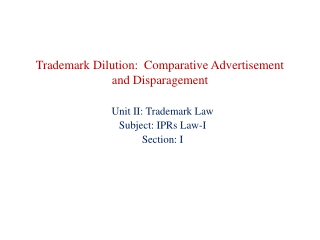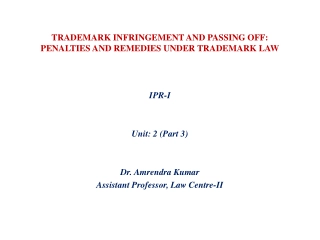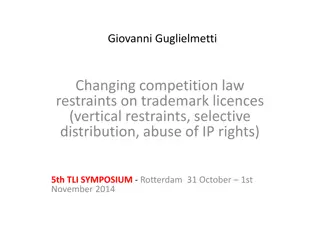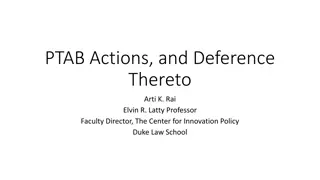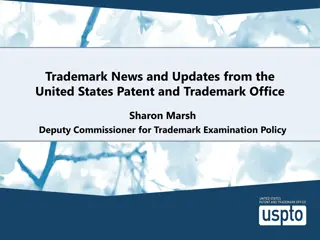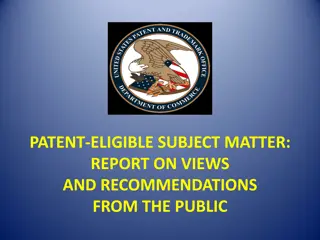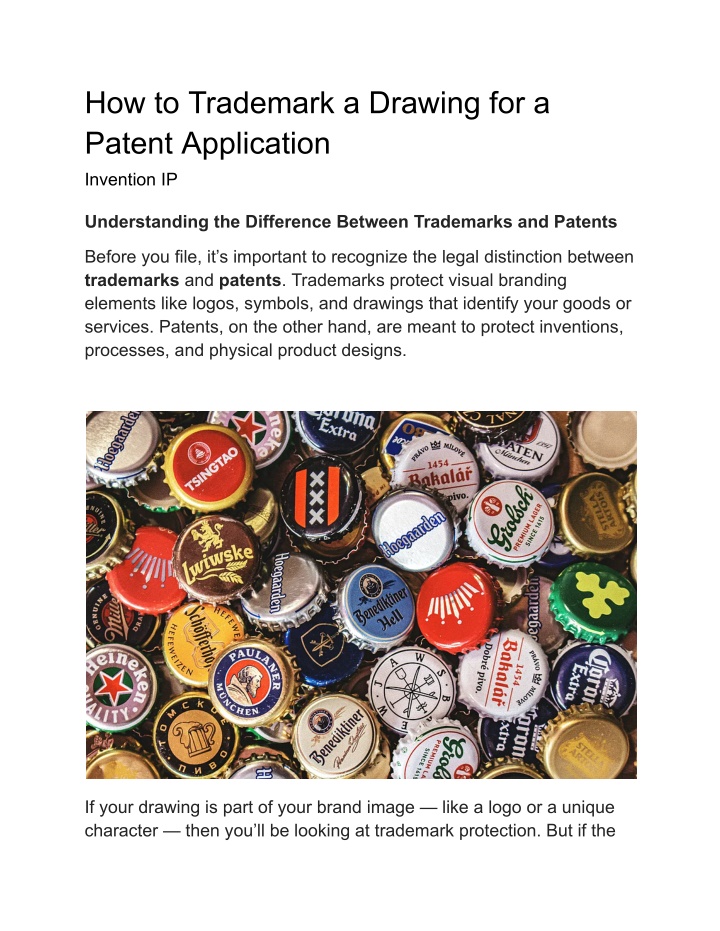
How to Trademark a Drawing for a Patent Application
Want to protect your logo or design? Learn how to trademark a drawing for your brand or patent application. This step-by-step guide covers eligibility, USPTO filing, examples, FAQs, and expert tips to safeguard your visual identity and avoid legal pi
Uploaded on | 0 Views
Download Presentation

Please find below an Image/Link to download the presentation.
The content on the website is provided AS IS for your information and personal use only. It may not be sold, licensed, or shared on other websites without obtaining consent from the author. If you encounter any issues during the download, it is possible that the publisher has removed the file from their server.
You are allowed to download the files provided on this website for personal or commercial use, subject to the condition that they are used lawfully. All files are the property of their respective owners.
The content on the website is provided AS IS for your information and personal use only. It may not be sold, licensed, or shared on other websites without obtaining consent from the author.
E N D
Presentation Transcript
How to Trademark a Drawing for a Patent Application Invention IP Understanding the Difference Between Trademarks and Patents Before you file, it s important to recognize the legal distinction between trademarks and patents. Trademarks protect visual branding elements like logos, symbols, and drawings that identify your goods or services. Patents, on the other hand, are meant to protect inventions, processes, and physical product designs. If your drawing is part of your brand image like a logo or a unique character then you ll be looking at trademark protection. But if the
drawing is a visual representation of a products functional or ornamental features, you might need to apply for a design patent instead. Can You Trademark a Drawing? Absolutely. As long as your drawing functions as a brand identifier and is used in commerce, it qualifies for trademark protection. If the drawing simply serves as decoration or has no commercial use, it likely won t meet the requirements. Example: The Nike Swoosh Take the iconic Nike Swoosh. It s not just a curved line it s an instantly recognizable symbol that represents the Nike brand. This drawing has been trademarked and is protected under U.S. law, showcasing how a simple image can hold massive brand value. When Is a Drawing Eligible for Trademark Protection? Your drawing must meet these key requirements: It should be unique and distinctive, not a generic image or common shape. It must be used in commerce, meaning it appears on your product, packaging, or promotional material. It cannot be confusingly similar to any existing registered trademarks. Drawings used in logos, stylized characters, or symbolic graphics can all qualify provided they help identify and distinguish your product or service from competitors. Step-by-Step Guide: How to Trademark a Drawing 1. Search Existing Trademarks
Start with a comprehensive search using the USPTOs TESS database. This step helps you avoid legal issues by ensuring no similar trademarks are already registered. You can also check online marketplaces, websites, and social platforms for potential conflicts. If you re unsure about interpreting the results, it s smart to consult an IP attorney or a trademark filing service. 2. Define the Drawing s Purpose Clearly define how and where your drawing will be used. Will it appear on packaging? Is it a logo or part of your marketing strategy? This helps determine the appropriate trademark classification, which is crucial for a successful application. 3. Select the Right Trademark Class Trademarks are divided into 45 international classes. Each class protects specific goods or services. For instance, if you re using the drawing on apparel, you ll likely file under Class 25. If the drawing appears on tech products, Class 9 may be appropriate. Choose the correct class to ensure your protection is valid in your industry. 4. Prepare a High-Quality Image Make sure your drawing is in the proper format before submitting it to the USPTO: Use a JPEG file format Ensure it s under 5MB Submit a clean, professional image Use black and white unless you want to register the color as part of your trademark
Simplicity is key. A clean, recognizable drawing is easier to enforce and remember. 5. Submit a Specimen of Use You ll need to upload a real-world example of how your drawing is being used commercially. This could be: A product label A website screenshot featuring the drawing A photo of packaging Mockups and future plans won t be accepted. The image must already be in use. 6. File Your Trademark Application Go to USPTO.gov and choose between: TEAS Plus (lower cost, more detailed upfront) TEAS Standard (more flexibility, slightly higher fee) You ll submit ownership information, a description of your drawing, the image file, and its classification. 7. Watch for Office Actions The USPTO will assign an examining attorney to review your application. If they notice issues, you ll receive an Office Action a formal letter asking for clarification or stating reasons for refusal. Responding quickly and thoroughly is crucial to keep your application on track. 8. Publication and Opposition Period Once accepted, your drawing will be published in the Official Gazette. This starts a 30-day window where anyone can oppose your
registration. If no one challenges it, your trademark will proceed to registration. 9. Maintenance and Renewal You must continue using your drawing and file required documents to maintain your trademark. Between the 5th and 6th year, file a Declaration of Use. At the 10-year mark, file a renewal. Consistent, visible use of your drawing is essential to keep your protection valid. Trademark or Design Patent: Which Do You Need? Here s a simplified way to decide: If your drawing is part of your brand identity, like a logo or mascot, get a trademark. If your drawing is part of a product s look, especially for visual appeal, consider a design patent.
Design patents typically expire after 15 years and dont require proof of use. Trademarks, on the other hand, can last forever if properly maintained and renewed. Example: Apple Inc. Apple uses both forms of protection. The apple logo is trademarked, ensuring brand protection. Meanwhile, the rounded edges of iPhones are protected through design patents. This dual protection ensures their visuals and identity stay safe from imitation. Frequently Asked Questions Can I trademark a hand-drawn image? Yes. Just digitize it into a clean, high-resolution format that meets USPTO requirements. Do I need to be using the drawing before I apply? You can file a trademark application based on intent to use, but you must eventually submit proof of actual use before registration. How long does it take to register a trademark? Most trademarks take 8 to 12 months from filing to registration, depending on complexity and objections. Do I need a lawyer to file? No, but hiring a professional can help avoid costly mistakes. Trademark filings are legal documents, and errors can result in denial or loss of rights. What happens if someone copies my drawing? If your drawing is trademarked, you can enforce your rights. Start with a cease-and-desist letter. If the infringement continues, legal action may follow.
Can I file for international protection? Yes. You can use the Madrid Protocol to file for trademark protection in multiple countries through a single application. Pro Tips for Successful Trademarking Keep it simple and original: The more distinct your drawing, the easier it is to register and defend. Document everything: Keep records of your drawing s creation and commercial use. Monitor your trademark: Use online tools to check for unauthorized use or similar trademarks. Use your drawing consistently: This strengthens your brand and supports your case in legal disputes. Conclusion Trademarking a drawing protects more than just your art it safeguards your brand, builds trust, and adds value to your business. Whether you re a solo creator or an established company, securing legal ownership of your visual identity is a smart move. Don t leave your hard work unprotected. If you re ready to get started or want expert guidance, help is just a click away. Protect your drawing today: Visit InventionIP.com to start your trademark journey now!


